Our view at Stack - Typeform is our go-to software if we need to ask a set of structured questions of a group of customers, prospects or leads. In summary, Typeform combines aesthetics, functionality, and flexibility. User-friendly form builder with interactive design, versatile question types, real-time data collection, 500+ integrations, and diverse templates. Ideal for engaging surveys and lead generation.
Like every customer experience manager, you’re always wondering how your customers feel. What are they thinking about? What do they want? What gets them out of bed in the morning? Do they actually like your products and services, or are they just being polite when they fill out your feedback surveys?
These are the questions that keep us up at night.
Fortunately, thanks to technology, it’s possible to get a straight answer to some of these questions! In the past you might have had to simply wonder about customer sentiment or rely on surveys that offer only good, bad, and indifferent answers, you can now measure customer sentiment data in powerful ways that can provide tangible value to your business and your bottom line.
Today, we’ll cover what customer sentiment is, why it matters, and how to measure it in order to maximize the utility of the data you collect.
Latest posts on Tips
What is customer sentiment?
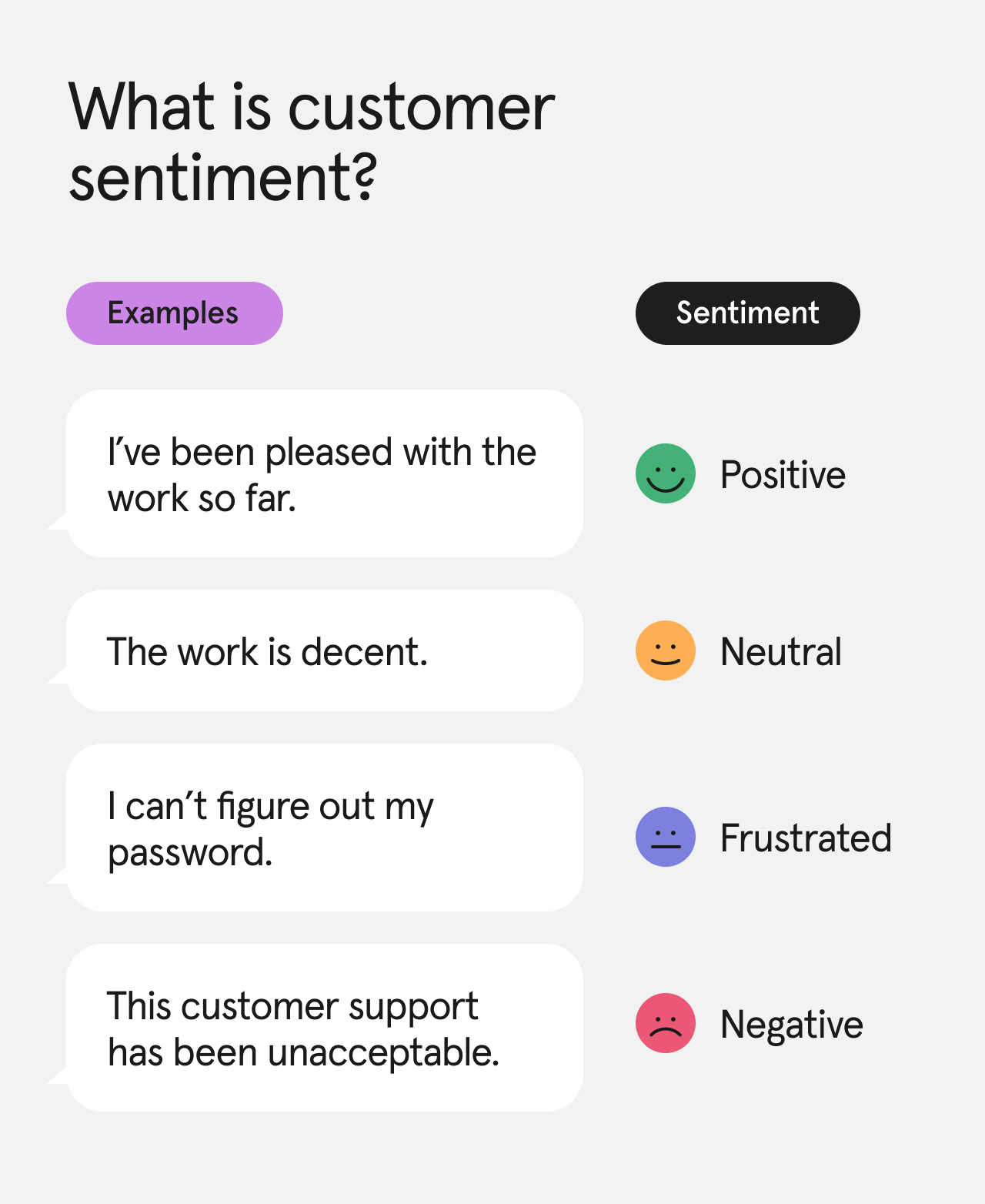
Customer sentiment is the metric companies use to measure how their customers feel about their brand, product, and services. It’s the method you use to quantify somewhat unquantifiable things, like consumer satisfaction, brand perception, and even customer loyalty.
Analyzing customer sentiment is critical for your brand’s long-term success. If you want to know how your customers think about your brand, what language they might use to describe your product, and whether they would recommend your brand, you need to measure and analyze customer sentiment.
The resulting data will provide critical insights into product wins and areas for improvement, current customer engagement and satisfaction, and even predictions for future customer loyalty.
How can you measure customer sentiment?
Customer sentiment analysis can be a tricky beast. On one hand, you’re trying to assign numbers to people’s feelings, which can feel like putting a square peg in a round hole. On the other hand, understanding these consumer sentiments is so critical for brand reputation and revenue that you have to try.
Here are some of the most common ways companies track customer sentiment—but be warned, some of them are a little off the beaten track.
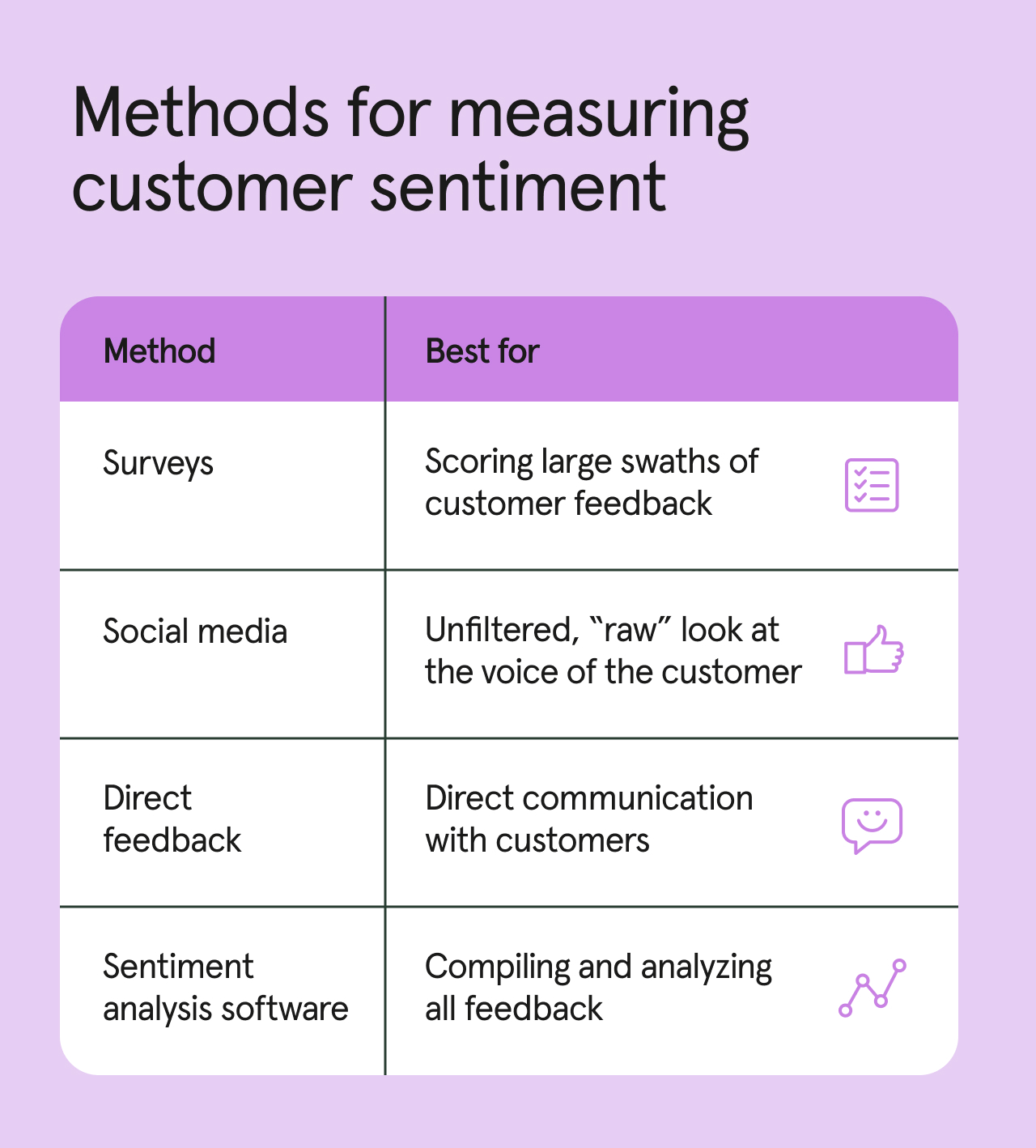
Customer sentiment surveys
First, there’s the classic approach: the customer sentiment survey. As mentioned above, this is what most people think of when measuring customer feelings. This approach uses surveys to ask customers different types of questions about their experience with your product or service. The approach is pretty simple, and based on the idea that if you want to know something… you can just ask.
There are a few different types of surveys that ask these critical questions, and each one generates a different type of “score” for the customer experience.
Here are a few of the most common:
-
CSAT: The Customer Satisfaction Score is one of the most popular metrics for customer sentiment. This score is based on answers to the question, “How satisfied were you with your experience shopping with us?” or similar, and asks respondents to rate their satisfaction on a scale of 1-10. You can then calculate your CSAT score based on the percentage of positive responses you received.
-
NPS: The Net Promoter Score is another popular metric. It measures customer satisfaction, experience, and/or sentiment by asking how likely a customer is to recommend a product or service. The score is based on answers to the question, “How likely are you to recommend [brand] to a friend or colleague?” or similar.
-
CES: The Customer Effort Score, or CES, tackles customer sentiment a bit differently. Instead of asking customers to directly rate your brand, you ask a question about the difficulty of the experience. You might ask, “How easy was it to resolve your support issue?” and provide options on a scale of 1-10. The resulting metric shows how “effortless” you may or may not have made the experience for your customer.
-
Custom scores: Of course, these aren’t the only options. You can also create your own scoring model based on your own questions if you want to base your analysis on a different type of customer opinion.
You can use a bespoke service, build the surveys by hand yourself, or outsource survey creation and management when it comes to distributing these surveys to your customer base.
Social media monitoring
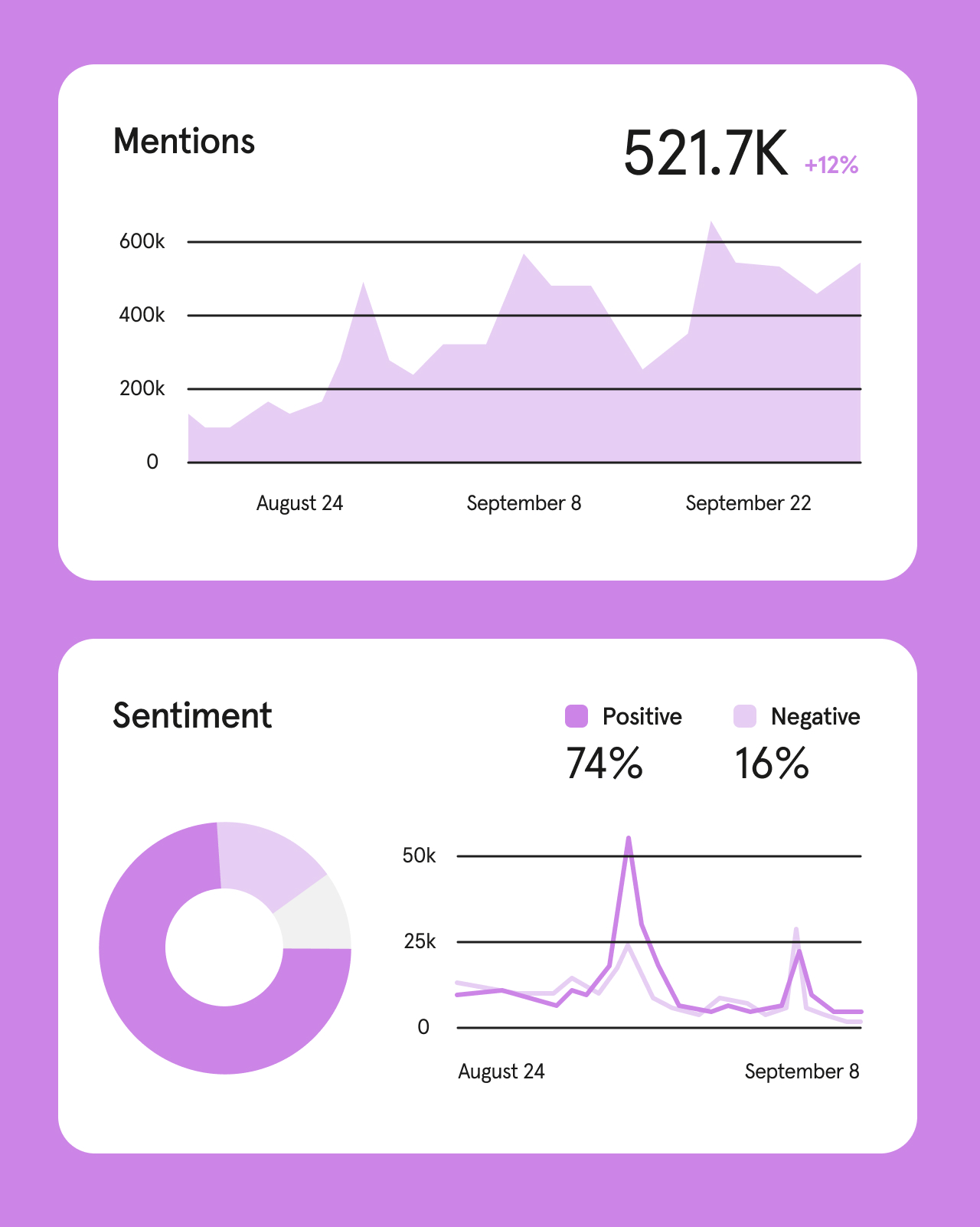
Another option for measuring customer sentiment is social media monitoring. While a little unorthodox—you’re not going to win Instagram, after all—tracking how your customers are talking about your brand online is still critical.
Most advanced social media management tools will have a social listening feature you can use for this. You can track mentions, hashtags, and sentiment across multiple social channels, usually all in one dashboard. Some tools will even give you a score based on positive, negative, or neutral words used in mentions of your brand.
Here are some of the most common social listening tools used to monitor customer engagement and sentiment on social media:
-
Hootsuite: Hootsuite is one of the most popular social media tools out there, with advanced features for both post scheduling and advanced sentiment analysis.
-
Sprout Social: Sprout’s social listening tools include insights beyond social media, surfacing data from around the web to provide a comprehensive sentiment analysis score.
-
BuzzSumo: Another comprehensive listening solution, BuzzSumo tracks both mentions and sentiment across the web to keep an eye on how your brand is represented across the internet.
Any one of these tools (or others similar) will deliver hard data on customer sentiment in the wild. Sometimes, customers won’t be entirely honest on surveys—or they’ll just be very polite—and keeping your ear to the ground on social can surface opinions you’d never have known about otherwise.
Direct feedback
Again, sometimes, there’s magic in just asking for direct feedback. Standard ways of asking for customer opinions still work, even if they require a little more analysis and manual review for the customer experience (CX) manager. This unstructured data can actually have some of the most valuable insights of all, as it allows the customer to speak directly in their own words.
Some common forms of direct feedback can include:
-
Forms: An open-ended customer feedback form that includes a blank text box can be a great alternative to a how-did-we-do survey with only three response options. This gives the customer the freedom to share more detailed thoughts.
-
Comment sections: While the thought of diving into a comment section can be intimidating, it’s worth scanning through the comments on social or using your social media monitoring tool to look for trends.
-
Email feedback: Do you have a support inbox? While it may be full of requests to reset passwords, you can also analyze these communications for wider trends about problem areas in the product or overall consumer experiences.
-
Any 1:1 interaction: Whether it’s customer service calls, emails, or handwritten letters, when your customers reach out to you, it’s important to listen. Any 1:1 customer interaction has the potential to offer insight into the customer experience.
As a whole, direct feedback can be less straightforward than surveys or scores but can still provide very valuable feedback. (And, of course, when qualitative and quantitative research combine, that’s where the real magic happens!)
Sentiment analysis software
Now, if you want to get really advanced, there’s a tool for that. Sentiment analysis software takes all the types of feedback we just discussed and utilizes artificial intelligence (AI) and/or machine learning to surface insights from that data. This software can find trends across channels and platforms and provide action items based on those trends.
While not all the customer feedback tools we’ve discussed offer high-level analysis options like this, Typeform’s Smart Insights does. If you use a Typeform form or survey to collect customer feedback, you’ll be able to view the results in an easy-to-read dashboard and have AI analyze the data based on your specific questions.
It’s like having your own personal data analyst for the customer experience!
Understanding how to analyze customer sentiment scores
Now that you know how to measure customer sentiment, what should you do with that information? Well, as with all types of data collection, once you have the raw information, you’ll want to analyze it for practical insights.
Here are some do’s and don’ts when it comes to analyzing customer sentiment scores or feedback:
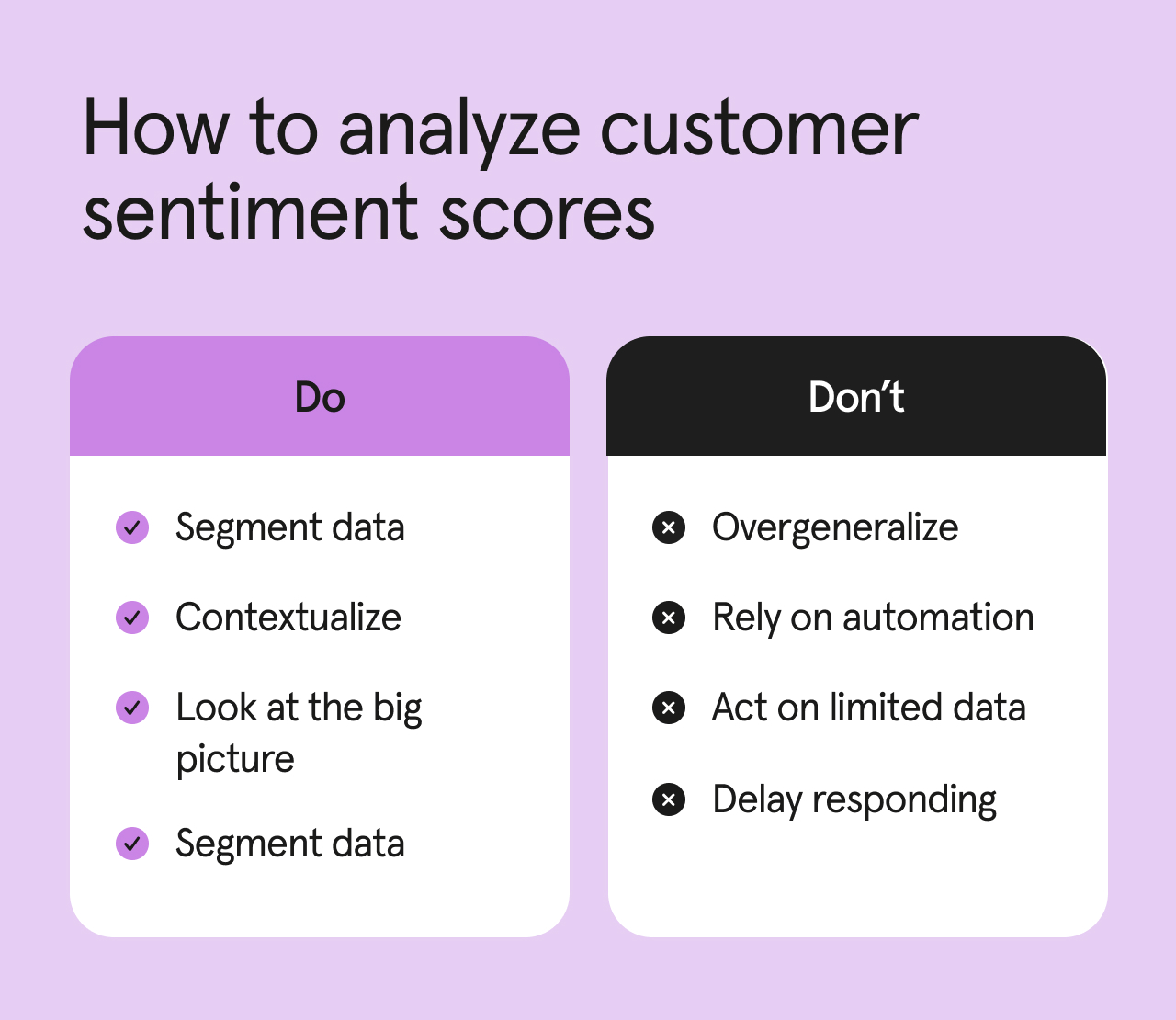
Do
When analyzing data on customer sentiment, incorporate these strategies into your process:
-
Segment data: Use customer segmentation to break down feedback by group. Understanding how customer feedback varies by group—like age, gender, or location—can help you understand who your ideal customer is and how to better cater to their needs.
-
Contextualize: Look for context that may explain patterns in data, like major holidays, temporary power outages, or natural disasters. Wide swings in data often have external explanations.
-
Look at the big picture: Look at quantitative and qualitative data side by side and look for patterns. CSAT scores and social media feedback combined, for example, can give a picture of customer sentiment that’s even more likely to be accurate.
-
Take action: Once you’ve analyzed your data and found areas for improvement, make sure you actually act to address those issues! All the data in the world won’t help you if you don’t use it to inform real change.
Don’t
When analyzing data on customer sentiment, watch out for these common mistakes:
-
Overgeneralize: Avoid making assumptions based on limited data—without segmentation, apparent trends can be misleading.
-
Rely on automation: An automatic “how did we do?” survey lacks nuance and won’t always yield the most accurate results. Examine automated surveys and analyses critically.
-
Act on limited data: Always make sure you base action items on a reasonable number of survey respondents to ensure your data accurately reflects a substantial portion of the customer base.
-
Delay responding: Especially if feedback is negative, take action quickly to show your customers you’ve heard their concerns and are working to resolve them. Failing to do so can harm your brand’s reputation.
Why does any of this matter? Well, a good CSAT, NPS, or CES score can be a great way to determine how likely a customer is to return and spend money with your brand again. In fact, increasing customer retention rates by just 5% can increase profits by 25% to 95%.
Learning to measure, score, and analyze customer sentiment is key to increasing customer loyalty and improving your bottom line in the long run.
Examples
That’s enough hypotheticals—let’s take a look at some examples of what measuring customer sentiment might look like in action.
Retail
A customer success team at a retail company might want to analyze customer sentiment scores to see the most successful customer service areas at a specific store. They might write a custom survey like the one below and distribute it to customers who have shopped at that location within the last 30 days to glean data about their experience.
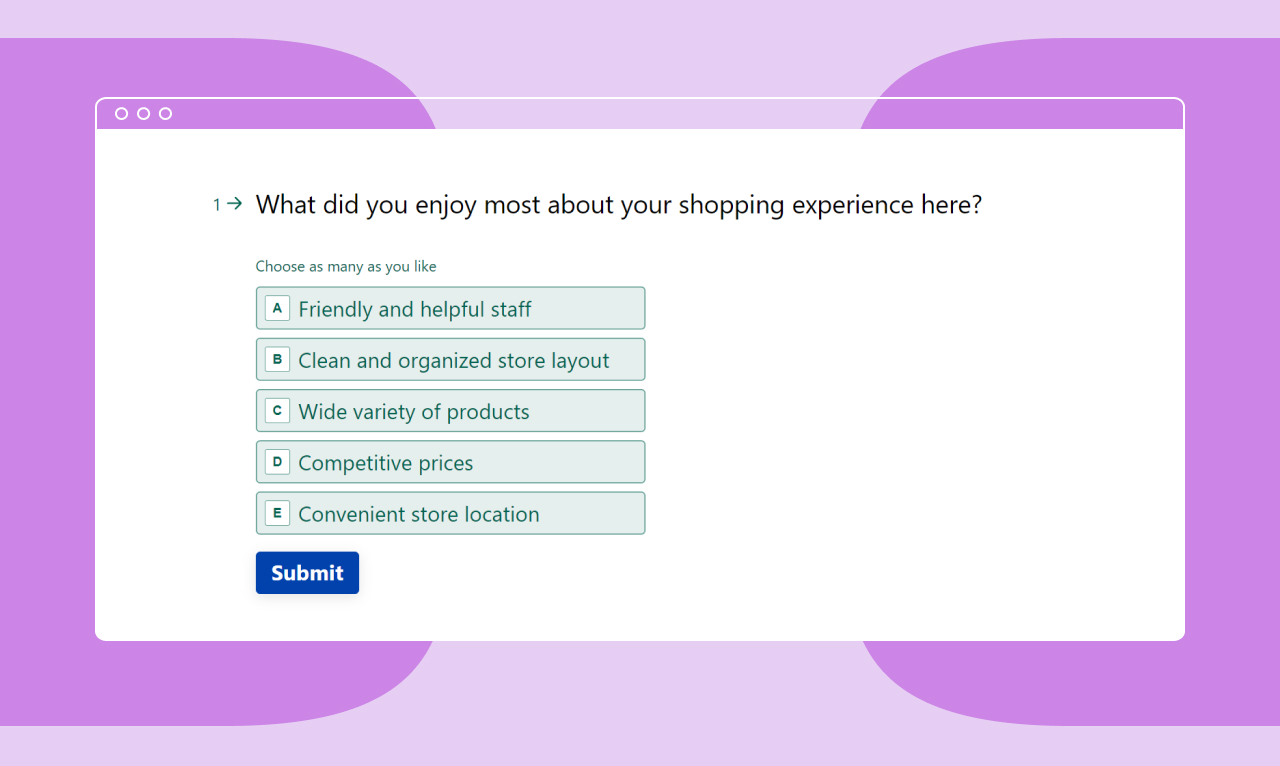
The results from this survey will be very valuable to this retail location. If, for example, many respondents answered “Friendly and helpful staff,” the store’s manager might choose to have staff from that location train staff at other locations in the chain.
As we can see in this example, you can use data from a simple survey question to inform organizational-wide changes.
Software as a Service (SaaS)
A SaaS company might survey customers to determine which features they use or prefer the most in their platform. A survey question like the one below could help a customer service or customer experience team find out which features are the most popular—especially if you recently introduced a new feature.
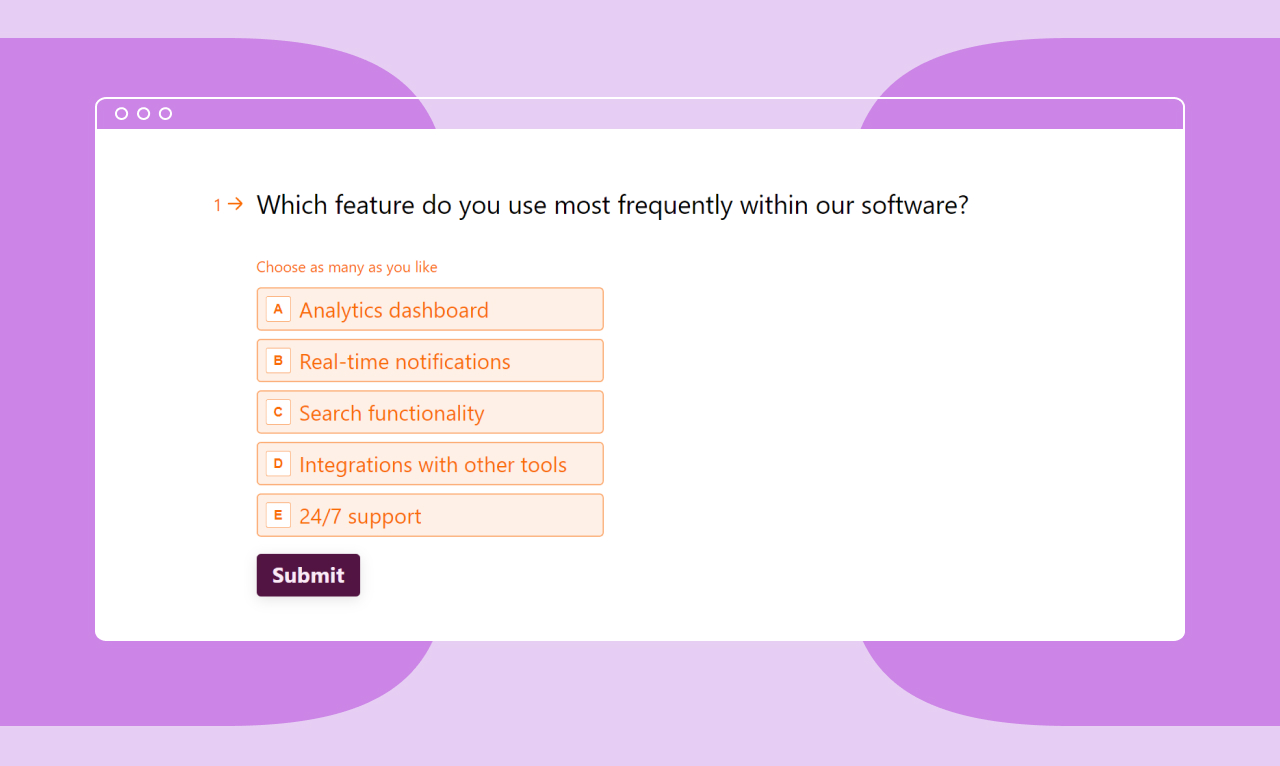
The results from a survey like this can help determine which features need improvement, which ones are most widely used, and which ones they should no longer support.
Personal finance
You’ve probably already experienced this one at some point in your life, assuming you bank online. A bank like yours might survey their customers to see how they feel about updates to the mobile application. The contents might include questions on ease of use, practical application, and what changes you might like to see in the application in the future.
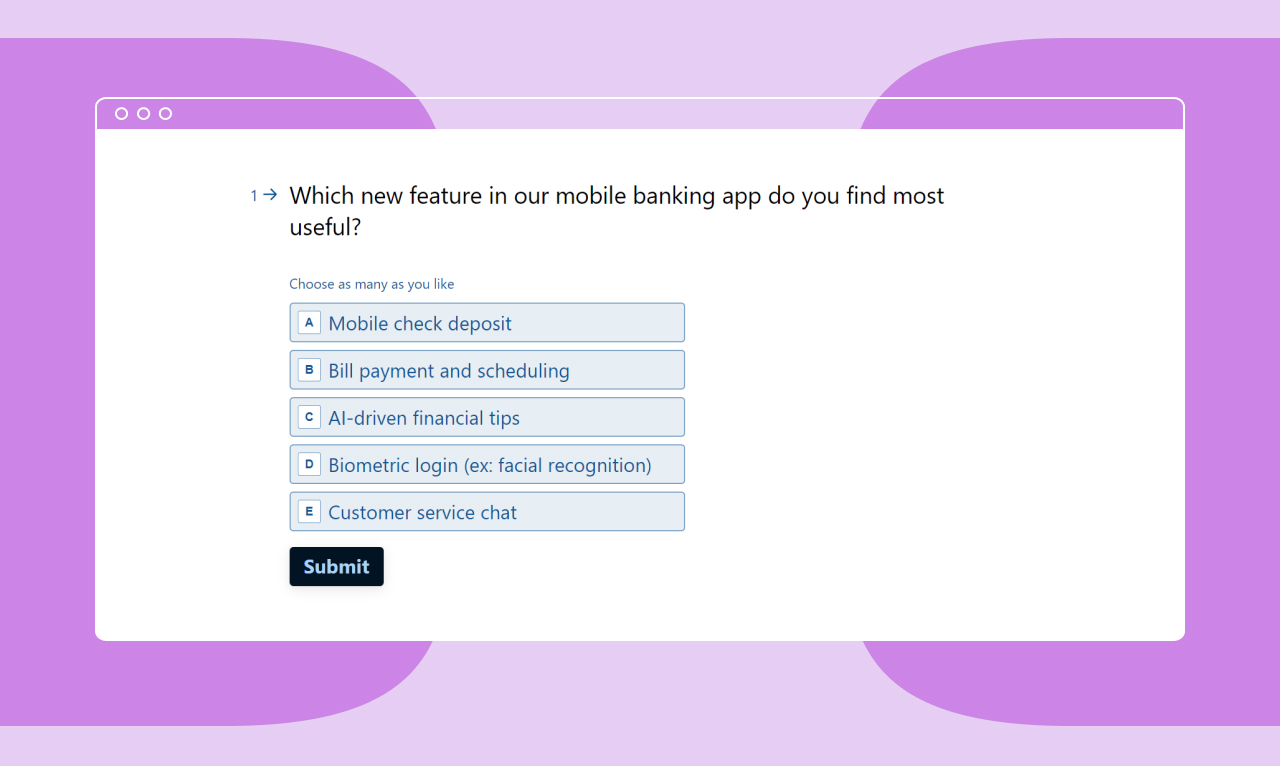
The answers to this question can help the bank’s customer experience team learn more about what their customers find most useful within the application. Maybe no one is using the AI-driven features—it’s important information and could lead to a sunset of that feature in the future.
This is a great opportunity to optimize budgets and focus resources on the areas that drive the most value for the customer.
Find out how your customers really feel with Typeform
Customer sentiment analysis is a crucial part of your customer experience strategy. As automation distances us from our end users, it’s becoming more critical to understand our customers and their needs—and stay one step ahead. Listening to your customers with advanced customer sentiment analysis tools is the best way to do that.
Want to learn how your customers really feel? Try Typeform for free to find out.
If Typeform is of interest and you'd like more information, please do make contact or take a look in more detail here.
Credit: Original article published here.
